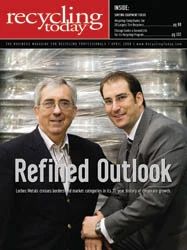The world’s steelmakers may finally be slowing down the growth rate of their production, but the production of more than 100 million metric tons of steel each month still requires a healthy amount of scrap.
Figures compiled by the International Iron and Steel Institute (IISI), Brussels, for February 2008 steel production show 5.3 percent growth over February 2007, with the 66 nations reporting to the IISI churning out some 107 million metric tons of product.
However, a moving annual total (MAT) growth rate calculated by the institute has shown a slowdown from a peak in March 2007 of 10.8 percent to 6.2 percent for early this year.
In particular, China’s MAT growth rate has slowed from 21 percent in February 2007 to 12.1 percent in February 2008. China’s MAT growth peaked in January 2006 at 26.3 percent.
A slower growth rate may finally ease some of the pressure on ferrous scrap supplies and help the market achieve something closer to equilibrium. A question remaining, however, is whether the ongoing global production of so much steel will require a lengthy time horizon for the scrap supply to begin reaching a point where buyers do not feel strained to obtain adequate supply.
For now, looking for supply and keeping up with demand continue to make the world seem like a busy place for scrap recyclers. "We’ve got a lot going on and we’re short-handed," sighs a shredder operator in Texas.
There is no shortage of destinations that wish to buy scrap; procuring enough to fill orders is the bigger problem. "People have to realize there is less and less scrap out there," says a Wisconsin recycler.
Adds a recycler from Tennessee, "The manufacturing segment is slowing and really not producing [scrap] at good levels."
Generation has not been helped by a slowdown on the demolition side of the business. A large demolition contractor in the South estimates a drop-off of about 25 percent in current business in the first two months of 2008 compared to 2007. He also calculates that quoting and bidding activity for the rest of the year is off by a similar percentage.
On the East Coast, a shredder operator cites a dramatic drop-off of material from the construction and demolition segments, even guessing that a 50 percent decline year-against year is not out of the question.
Several factors creating the drop-off are cited by both sources, each of whom does not wish to conclude that the pattern is long-term. A snowy and icy (in the North) or soggy and windy (in the South) winter have made adhering to construction schedules difficult, which could explain some of the tapering off in generation in February.
Beyond the seasonal aspects, what is hoped to be some temporary tightness in credit markets also is being singled out, as is a gap between federal and state highway funding periods that has slowed down some bridge repair and replacement work.
In Texas, the state’s Department of Transportation (TxDOT) has been urged by some legislators to seek new funding, perhaps even borrowing money, to keep critical infrastructure projects moving forward.
Overall manufacturing activity in the United States remains weak, with one mid-March study from the Federal Reserve Bank of Philadelphia showing relative weakness prevailing.
The dispiriting statistics may finally be eroding the confidence of commodity traders. As March was winding down, pricing for copper, gold and other metallic commodities exhibited some negative spikes, with copper losing 6.6 percent of its value in one week in mid-March.
How and when these daily and weekly drops will affect steel and ferrous scrap pricing remains to be seen.
Looking at the immediate future, despite the turbulence in the North American financial industry and a homebuilding industry that has fallen off significantly, North American steelmakers increased production to 10.9 million metric tons in February, up more than 5 percent from the same month in 2007.
Even the MAT growth rate in North America is showing signs of improvement, with five consecutive months of growth, indicating either that some manufacturing sectors remain healthy, despite the lending industry woes, or that steelmakers in North America are successfully exporting more product thanks to the weak dollar.
Healthy steel markets exist in Brazil, which produced 2.7 million metric tons of crude steel in February, an increase of more than 8 percent year over year, and in Turkey, which produced 2.2 million metric tons for an increase of 14.7 percent.
(Additional news about ferrous scrap, including breaking news and consuming industry reports, is available online at www.RecyclingToday.com.)

Explore the April 2008 Issue
Check out more from this issue and find your next story to read.
Latest from Recycling Today
- Athens Services terminates contract with San Marino, California
- Partners develop specialty response vehicles for LIB fires
- Sonoco cites OCC shortage for price hike in Europe
- British Steel mill’s future up in the air
- Tomra applies GAINnext AI technology to upgrade wrought aluminum scrap
- Redwood Materials partners with Isuzu Commercial Truck
- The push for more supply
- ReMA PSI Chapter adds 7 members






